Report on Queensland Aboriginal and Islander Health Council
VerifiedAdded on 2023/06/08
|12
|2326
|94
AI Summary
This report discusses the Queensland Aboriginal and Islander Health Council and its efforts towards reducing health disparities among Aboriginal and Torres Strait Islander individuals in Queensland. It covers the history, vision, objectives, work, membership, and challenges faced by the organization.
Contribute Materials
Your contribution can guide someone’s learning journey. Share your
documents today.
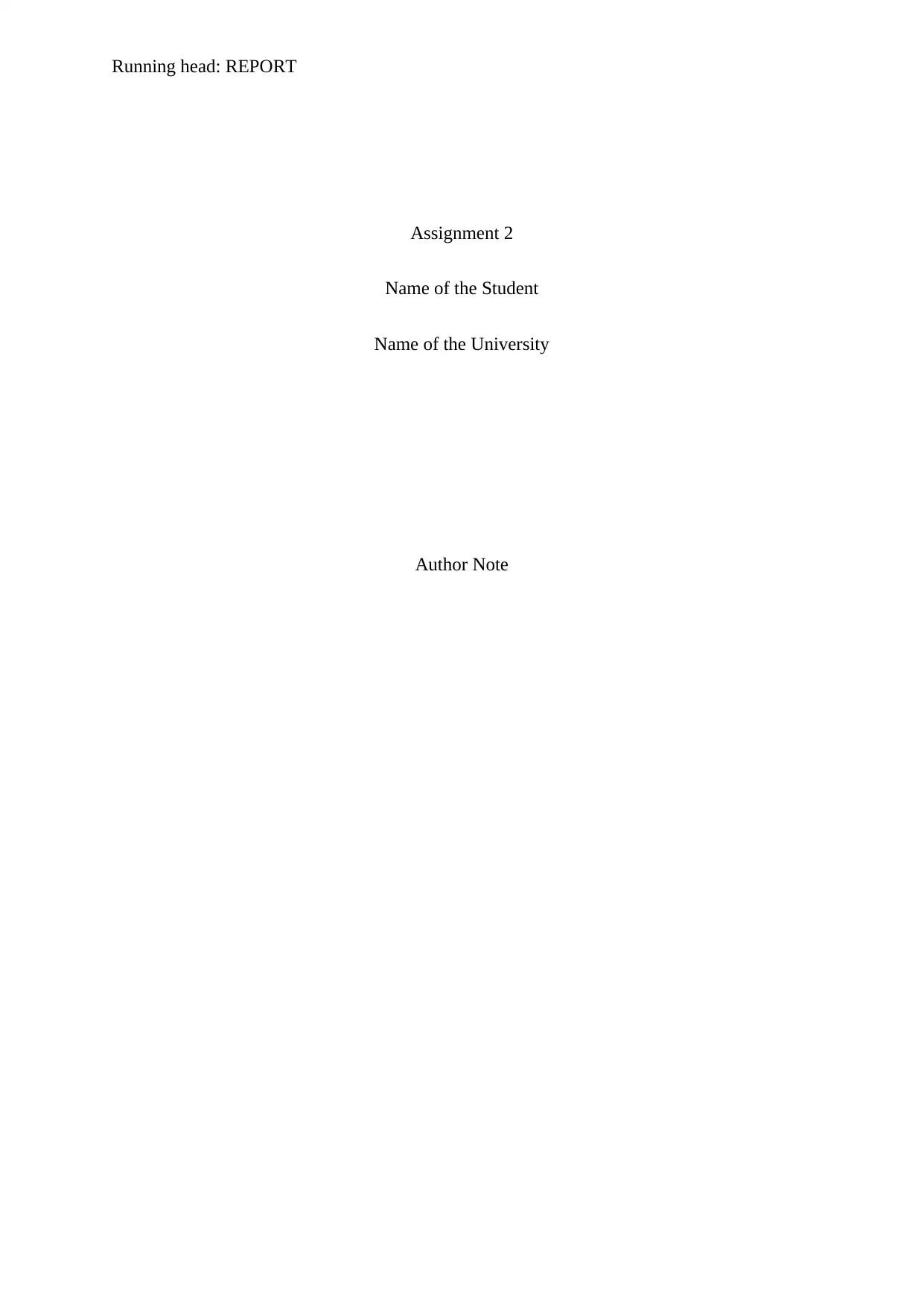
Running head: REPORT
Assignment 2
Name of the Student
Name of the University
Author Note
Assignment 2
Name of the Student
Name of the University
Author Note
Secure Best Marks with AI Grader
Need help grading? Try our AI Grader for instant feedback on your assignments.
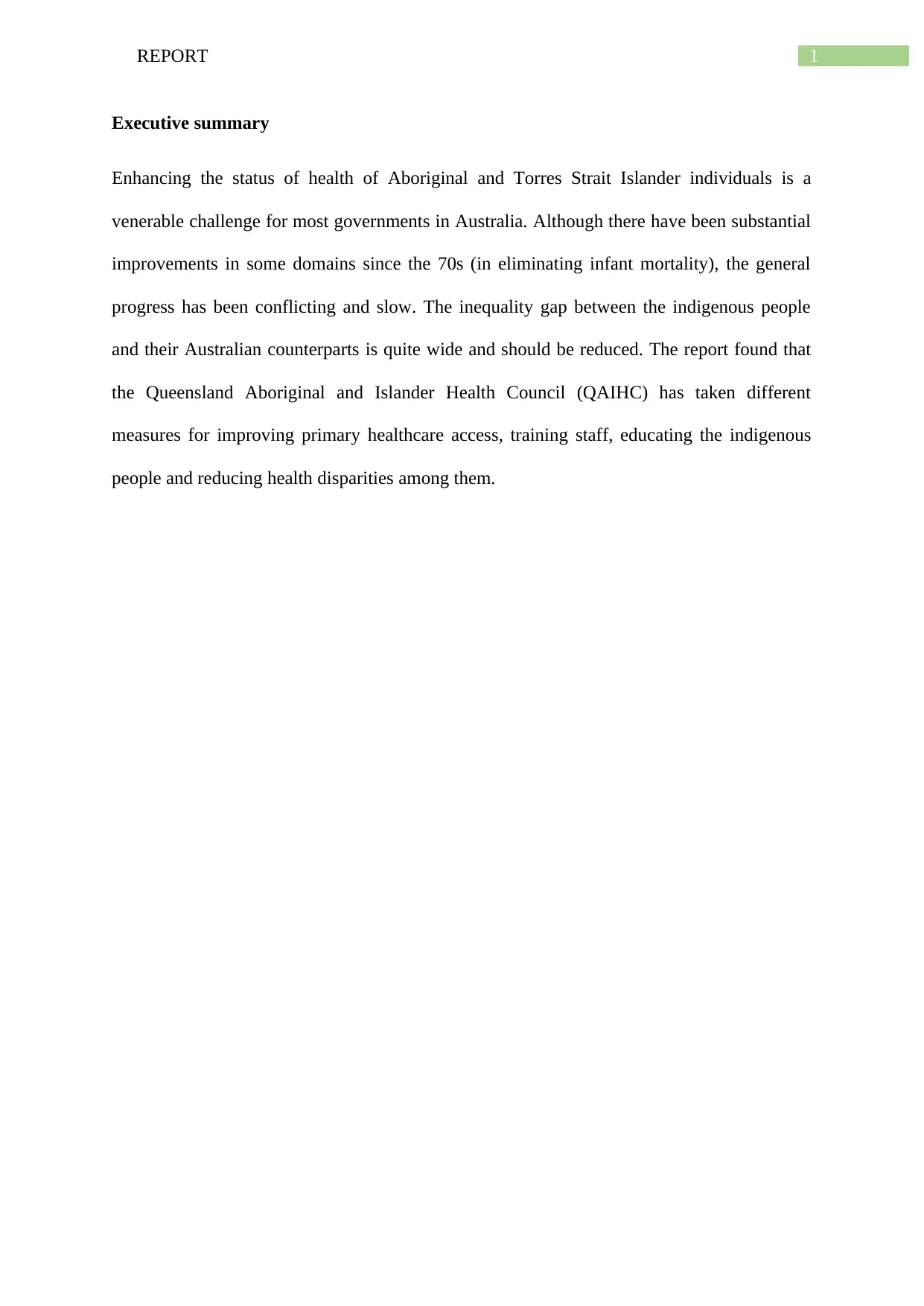
1REPORT
Executive summary
Enhancing the status of health of Aboriginal and Torres Strait Islander individuals is a
venerable challenge for most governments in Australia. Although there have been substantial
improvements in some domains since the 70s (in eliminating infant mortality), the general
progress has been conflicting and slow. The inequality gap between the indigenous people
and their Australian counterparts is quite wide and should be reduced. The report found that
the Queensland Aboriginal and Islander Health Council (QAIHC) has taken different
measures for improving primary healthcare access, training staff, educating the indigenous
people and reducing health disparities among them.
Executive summary
Enhancing the status of health of Aboriginal and Torres Strait Islander individuals is a
venerable challenge for most governments in Australia. Although there have been substantial
improvements in some domains since the 70s (in eliminating infant mortality), the general
progress has been conflicting and slow. The inequality gap between the indigenous people
and their Australian counterparts is quite wide and should be reduced. The report found that
the Queensland Aboriginal and Islander Health Council (QAIHC) has taken different
measures for improving primary healthcare access, training staff, educating the indigenous
people and reducing health disparities among them.

2REPORT
Table of Contents
Introduction................................................................................................................................3
Profile.........................................................................................................................................3
Brief History...........................................................................................................................3
Vision and objectives.............................................................................................................4
Work.......................................................................................................................................4
Membership............................................................................................................................5
Contact and Location.............................................................................................................6
Issues and challenges.............................................................................................................6
Comments and personal reflections...........................................................................................7
General issues.............................................................................................................................8
Conclusion..................................................................................................................................9
References................................................................................................................................10
Table of Contents
Introduction................................................................................................................................3
Profile.........................................................................................................................................3
Brief History...........................................................................................................................3
Vision and objectives.............................................................................................................4
Work.......................................................................................................................................4
Membership............................................................................................................................5
Contact and Location.............................................................................................................6
Issues and challenges.............................................................................................................6
Comments and personal reflections...........................................................................................7
General issues.............................................................................................................................8
Conclusion..................................................................................................................................9
References................................................................................................................................10
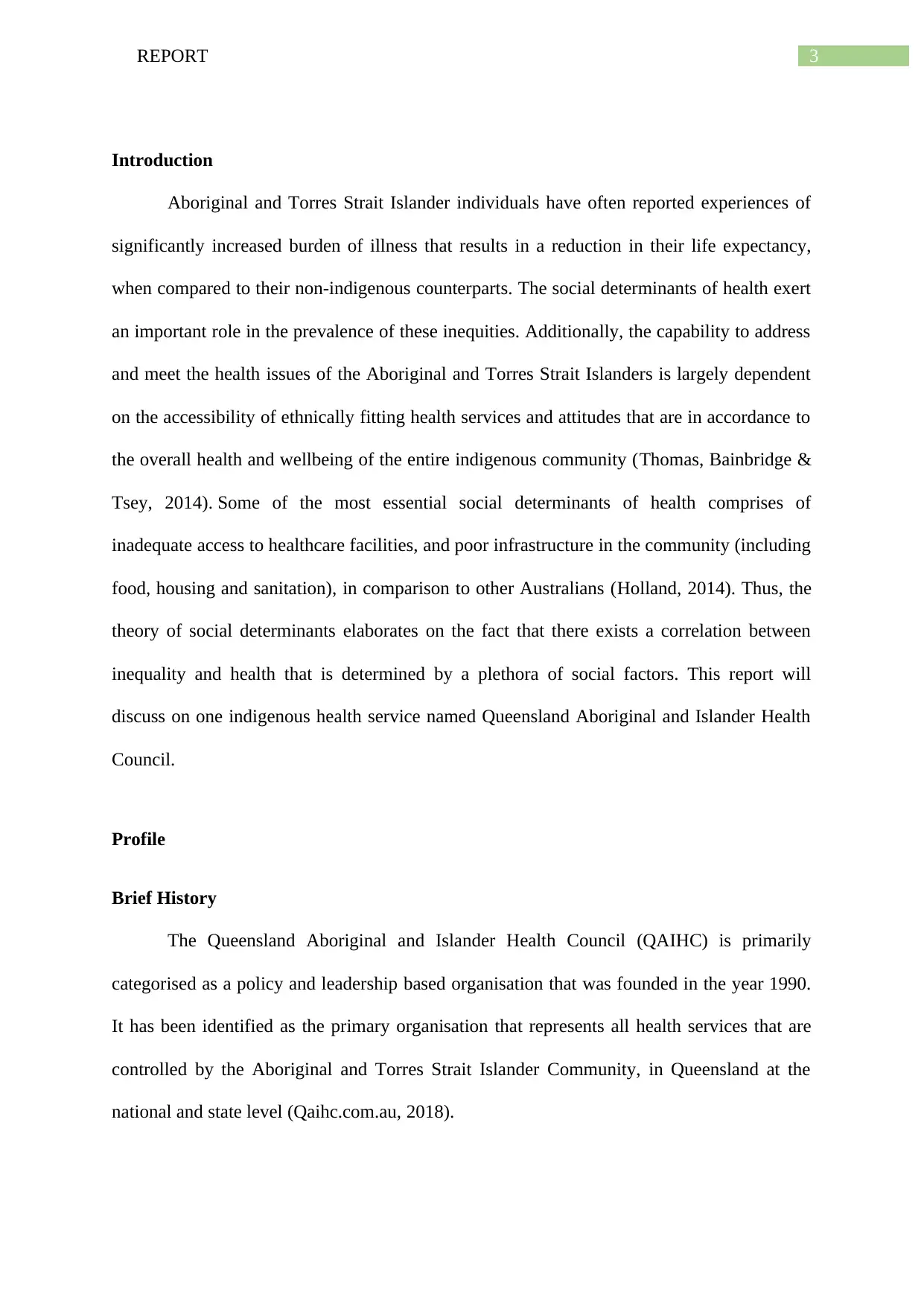
3REPORT
Introduction
Aboriginal and Torres Strait Islander individuals have often reported experiences of
significantly increased burden of illness that results in a reduction in their life expectancy,
when compared to their non-indigenous counterparts. The social determinants of health exert
an important role in the prevalence of these inequities. Additionally, the capability to address
and meet the health issues of the Aboriginal and Torres Strait Islanders is largely dependent
on the accessibility of ethnically fitting health services and attitudes that are in accordance to
the overall health and wellbeing of the entire indigenous community (Thomas, Bainbridge &
Tsey, 2014). Some of the most essential social determinants of health comprises of
inadequate access to healthcare facilities, and poor infrastructure in the community (including
food, housing and sanitation), in comparison to other Australians (Holland, 2014). Thus, the
theory of social determinants elaborates on the fact that there exists a correlation between
inequality and health that is determined by a plethora of social factors. This report will
discuss on one indigenous health service named Queensland Aboriginal and Islander Health
Council.
Profile
Brief History
The Queensland Aboriginal and Islander Health Council (QAIHC) is primarily
categorised as a policy and leadership based organisation that was founded in the year 1990.
It has been identified as the primary organisation that represents all health services that are
controlled by the Aboriginal and Torres Strait Islander Community, in Queensland at the
national and state level (Qaihc.com.au, 2018).
Introduction
Aboriginal and Torres Strait Islander individuals have often reported experiences of
significantly increased burden of illness that results in a reduction in their life expectancy,
when compared to their non-indigenous counterparts. The social determinants of health exert
an important role in the prevalence of these inequities. Additionally, the capability to address
and meet the health issues of the Aboriginal and Torres Strait Islanders is largely dependent
on the accessibility of ethnically fitting health services and attitudes that are in accordance to
the overall health and wellbeing of the entire indigenous community (Thomas, Bainbridge &
Tsey, 2014). Some of the most essential social determinants of health comprises of
inadequate access to healthcare facilities, and poor infrastructure in the community (including
food, housing and sanitation), in comparison to other Australians (Holland, 2014). Thus, the
theory of social determinants elaborates on the fact that there exists a correlation between
inequality and health that is determined by a plethora of social factors. This report will
discuss on one indigenous health service named Queensland Aboriginal and Islander Health
Council.
Profile
Brief History
The Queensland Aboriginal and Islander Health Council (QAIHC) is primarily
categorised as a policy and leadership based organisation that was founded in the year 1990.
It has been identified as the primary organisation that represents all health services that are
controlled by the Aboriginal and Torres Strait Islander Community, in Queensland at the
national and state level (Qaihc.com.au, 2018).
Secure Best Marks with AI Grader
Need help grading? Try our AI Grader for instant feedback on your assignments.

4REPORT
Vision and objectives
The primary vision of the QAIHC is to eliminate all the existing disparities in the
health and overall wellbeing that are commonly experienced by the Aboriginal and Torres
Strait Islander individuals, residing in Queensland. Thus, the organisation has the vision of
developing a sustainable, skilled and culturally responsive workforce for primary healthcare
that will address the inequities that the indigenous people commonly encounter in the
community (Qaihc.com.au, 2018). A recent step towards achieving this vision was facilitated
by signing of an agreement by the chairperson Elizabeth Adams for developing and retaining
primary healthcare workforce, which will show a commitment towards delivering excellence
to the indigenous people of Queensland.
Work
The organisation is responsible for delivering and supporting activities that have been
formulated with the aim of enhancing the capacity and capability of the healthcare sector.
The QAIHC provides support, education, advice, and training that are delivered by qualified
and experienced workforce coordinators. Their primary role is to focus on workforce
planning and development, cultural capability and education, chronic disease, continuous
quality improvement, accreditation, and Medicare (Qaihc.com.au, 2018).. The QAIHC also
dedicates funding that allows them to provide coordinated advice and support to all member
services related to specific health issues, which also encompass diabetes, immunization,
hearing health, drug abuse, and alcoholism. The Health Program Unit of QAIHC is also
responsible for maintaining Finance Leaders Forum that emphasizes on issues and methods
of current financial interest and human resource management.
The QAIHC also has a social and emotional wellbeing unit (SEWB) that supports the
workforce in Queensland, which is funded through the Cabinet and the Prime Minister. This
unit creates provisions for annual Training Needs Analysis where an estimated 150 workers
Vision and objectives
The primary vision of the QAIHC is to eliminate all the existing disparities in the
health and overall wellbeing that are commonly experienced by the Aboriginal and Torres
Strait Islander individuals, residing in Queensland. Thus, the organisation has the vision of
developing a sustainable, skilled and culturally responsive workforce for primary healthcare
that will address the inequities that the indigenous people commonly encounter in the
community (Qaihc.com.au, 2018). A recent step towards achieving this vision was facilitated
by signing of an agreement by the chairperson Elizabeth Adams for developing and retaining
primary healthcare workforce, which will show a commitment towards delivering excellence
to the indigenous people of Queensland.
Work
The organisation is responsible for delivering and supporting activities that have been
formulated with the aim of enhancing the capacity and capability of the healthcare sector.
The QAIHC provides support, education, advice, and training that are delivered by qualified
and experienced workforce coordinators. Their primary role is to focus on workforce
planning and development, cultural capability and education, chronic disease, continuous
quality improvement, accreditation, and Medicare (Qaihc.com.au, 2018).. The QAIHC also
dedicates funding that allows them to provide coordinated advice and support to all member
services related to specific health issues, which also encompass diabetes, immunization,
hearing health, drug abuse, and alcoholism. The Health Program Unit of QAIHC is also
responsible for maintaining Finance Leaders Forum that emphasizes on issues and methods
of current financial interest and human resource management.
The QAIHC also has a social and emotional wellbeing unit (SEWB) that supports the
workforce in Queensland, which is funded through the Cabinet and the Prime Minister. This
unit creates provisions for annual Training Needs Analysis where an estimated 150 workers
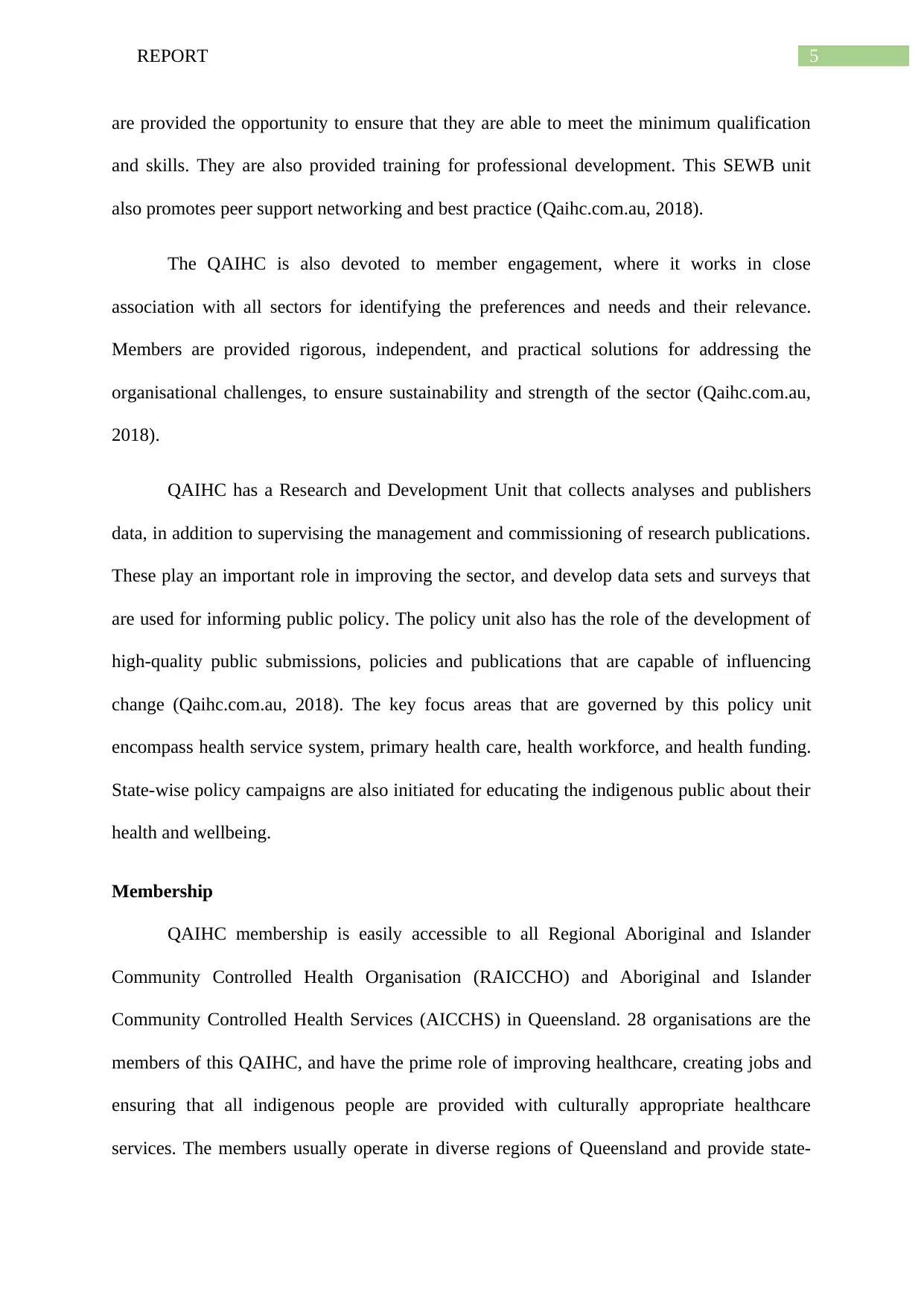
5REPORT
are provided the opportunity to ensure that they are able to meet the minimum qualification
and skills. They are also provided training for professional development. This SEWB unit
also promotes peer support networking and best practice (Qaihc.com.au, 2018).
The QAIHC is also devoted to member engagement, where it works in close
association with all sectors for identifying the preferences and needs and their relevance.
Members are provided rigorous, independent, and practical solutions for addressing the
organisational challenges, to ensure sustainability and strength of the sector (Qaihc.com.au,
2018).
QAIHC has a Research and Development Unit that collects analyses and publishers
data, in addition to supervising the management and commissioning of research publications.
These play an important role in improving the sector, and develop data sets and surveys that
are used for informing public policy. The policy unit also has the role of the development of
high-quality public submissions, policies and publications that are capable of influencing
change (Qaihc.com.au, 2018). The key focus areas that are governed by this policy unit
encompass health service system, primary health care, health workforce, and health funding.
State-wise policy campaigns are also initiated for educating the indigenous public about their
health and wellbeing.
Membership
QAIHC membership is easily accessible to all Regional Aboriginal and Islander
Community Controlled Health Organisation (RAICCHO) and Aboriginal and Islander
Community Controlled Health Services (AICCHS) in Queensland. 28 organisations are the
members of this QAIHC, and have the prime role of improving healthcare, creating jobs and
ensuring that all indigenous people are provided with culturally appropriate healthcare
services. The members usually operate in diverse regions of Queensland and provide state-
are provided the opportunity to ensure that they are able to meet the minimum qualification
and skills. They are also provided training for professional development. This SEWB unit
also promotes peer support networking and best practice (Qaihc.com.au, 2018).
The QAIHC is also devoted to member engagement, where it works in close
association with all sectors for identifying the preferences and needs and their relevance.
Members are provided rigorous, independent, and practical solutions for addressing the
organisational challenges, to ensure sustainability and strength of the sector (Qaihc.com.au,
2018).
QAIHC has a Research and Development Unit that collects analyses and publishers
data, in addition to supervising the management and commissioning of research publications.
These play an important role in improving the sector, and develop data sets and surveys that
are used for informing public policy. The policy unit also has the role of the development of
high-quality public submissions, policies and publications that are capable of influencing
change (Qaihc.com.au, 2018). The key focus areas that are governed by this policy unit
encompass health service system, primary health care, health workforce, and health funding.
State-wise policy campaigns are also initiated for educating the indigenous public about their
health and wellbeing.
Membership
QAIHC membership is easily accessible to all Regional Aboriginal and Islander
Community Controlled Health Organisation (RAICCHO) and Aboriginal and Islander
Community Controlled Health Services (AICCHS) in Queensland. 28 organisations are the
members of this QAIHC, and have the prime role of improving healthcare, creating jobs and
ensuring that all indigenous people are provided with culturally appropriate healthcare
services. The members usually operate in diverse regions of Queensland and provide state-
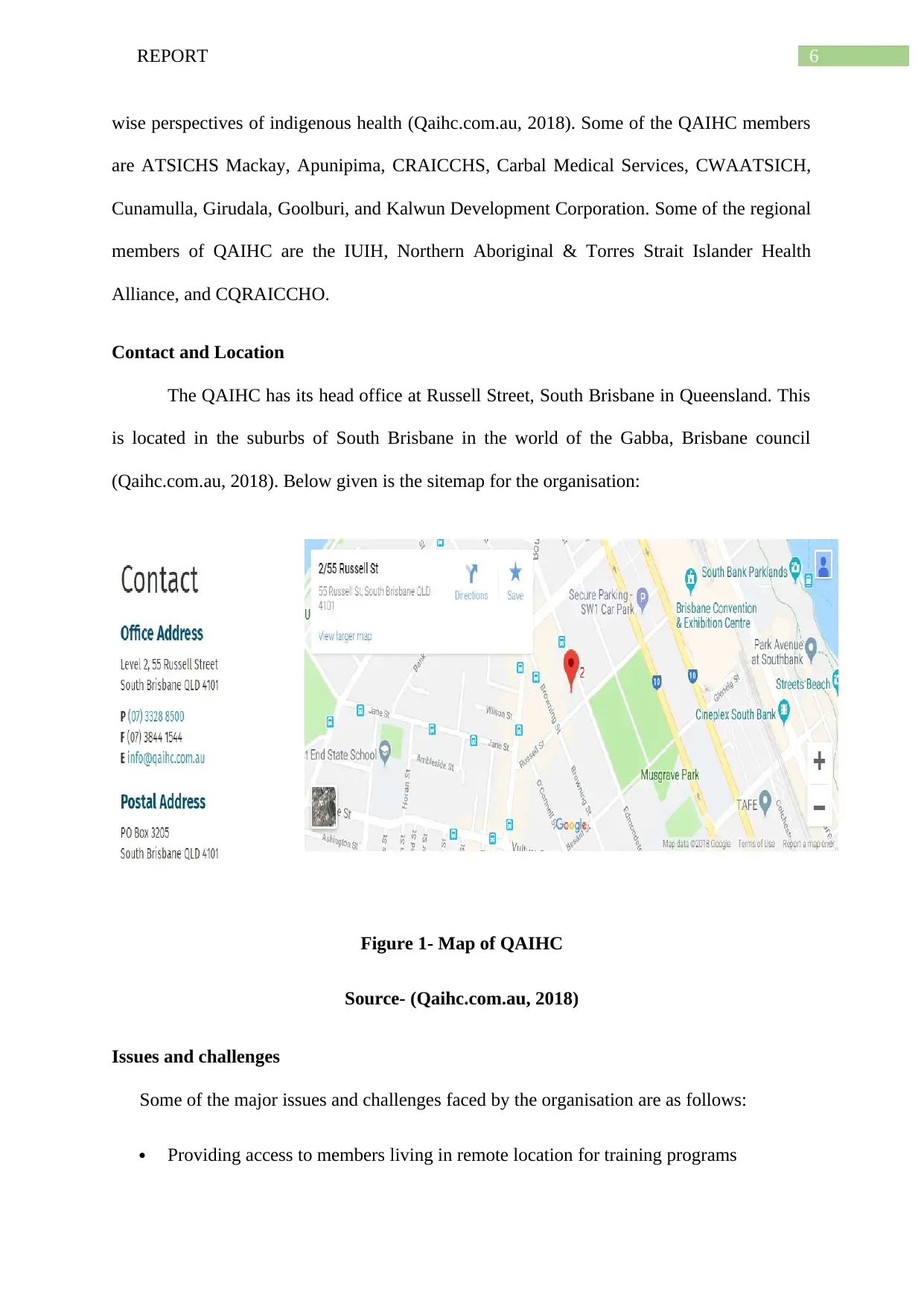
6REPORT
wise perspectives of indigenous health (Qaihc.com.au, 2018). Some of the QAIHC members
are ATSICHS Mackay, Apunipima, CRAICCHS, Carbal Medical Services, CWAATSICH,
Cunamulla, Girudala, Goolburi, and Kalwun Development Corporation. Some of the regional
members of QAIHC are the IUIH, Northern Aboriginal & Torres Strait Islander Health
Alliance, and CQRAICCHO.
Contact and Location
The QAIHC has its head office at Russell Street, South Brisbane in Queensland. This
is located in the suburbs of South Brisbane in the world of the Gabba, Brisbane council
(Qaihc.com.au, 2018). Below given is the sitemap for the organisation:
Figure 1- Map of QAIHC
Source- (Qaihc.com.au, 2018)
Issues and challenges
Some of the major issues and challenges faced by the organisation are as follows:
Providing access to members living in remote location for training programs
wise perspectives of indigenous health (Qaihc.com.au, 2018). Some of the QAIHC members
are ATSICHS Mackay, Apunipima, CRAICCHS, Carbal Medical Services, CWAATSICH,
Cunamulla, Girudala, Goolburi, and Kalwun Development Corporation. Some of the regional
members of QAIHC are the IUIH, Northern Aboriginal & Torres Strait Islander Health
Alliance, and CQRAICCHO.
Contact and Location
The QAIHC has its head office at Russell Street, South Brisbane in Queensland. This
is located in the suburbs of South Brisbane in the world of the Gabba, Brisbane council
(Qaihc.com.au, 2018). Below given is the sitemap for the organisation:
Figure 1- Map of QAIHC
Source- (Qaihc.com.au, 2018)
Issues and challenges
Some of the major issues and challenges faced by the organisation are as follows:
Providing access to members living in remote location for training programs
Paraphrase This Document
Need a fresh take? Get an instant paraphrase of this document with our AI Paraphraser

7REPORT
Increasing awareness among the members on health issues
Delivering updated information on all the issues that affect the management and board
Facilitating engagement of members (Qaihc.com.au, 2018).
Creating provisions for diagnosis and intervention-based staff trainings or workshop
Fighting homelessness among the Aboriginals and Torres Strait islanders
Comments and personal reflections
I am well acquainted with the poor health status that exists among the Aboriginals and
Torres Strait Islanders, due to presence of substantial inequalities, when compared to their
non-indigenous counterparts. Governments have tried to make several commitments for
addressing this health inequality, over a prolonged period of time and their efforts are usually
accompanied by increased funding (Holland, 2014). Despite all the efforts made by the
government I realise that not much improvement has been observed in their health status,
over the past decades. There are too few gains in relation to enhanced quality of life of the
Aboriginal and Torres Strait Islander people. Upon analysing the organisation QAIHC, I
realise that it is working towards a crucial objective of reducing or eliminating all kinds of
inequalities and disparities that are experienced by the indigenous people in their health and
quality of life. The efforts made by this organisation towards improving healthcare access,
providing adequate training and education to their staff, and reducing homelessness among
the indigenous people are praiseworthy. This is attributed to the disturbing trends of health
crisis among the target population (Ilton et al., 2014).
Indigenous people show high rates of chronic disease namely, cardiovascular
disorders, renal failure, and diabetes, and also manifest higher rates of poor health owing to
reduced access to primary healthcare services. Thus, the work of QAIHC in formulating a
Increasing awareness among the members on health issues
Delivering updated information on all the issues that affect the management and board
Facilitating engagement of members (Qaihc.com.au, 2018).
Creating provisions for diagnosis and intervention-based staff trainings or workshop
Fighting homelessness among the Aboriginals and Torres Strait islanders
Comments and personal reflections
I am well acquainted with the poor health status that exists among the Aboriginals and
Torres Strait Islanders, due to presence of substantial inequalities, when compared to their
non-indigenous counterparts. Governments have tried to make several commitments for
addressing this health inequality, over a prolonged period of time and their efforts are usually
accompanied by increased funding (Holland, 2014). Despite all the efforts made by the
government I realise that not much improvement has been observed in their health status,
over the past decades. There are too few gains in relation to enhanced quality of life of the
Aboriginal and Torres Strait Islander people. Upon analysing the organisation QAIHC, I
realise that it is working towards a crucial objective of reducing or eliminating all kinds of
inequalities and disparities that are experienced by the indigenous people in their health and
quality of life. The efforts made by this organisation towards improving healthcare access,
providing adequate training and education to their staff, and reducing homelessness among
the indigenous people are praiseworthy. This is attributed to the disturbing trends of health
crisis among the target population (Ilton et al., 2014).
Indigenous people show high rates of chronic disease namely, cardiovascular
disorders, renal failure, and diabetes, and also manifest higher rates of poor health owing to
reduced access to primary healthcare services. Thus, the work of QAIHC in formulating a

8REPORT
sustainable primary healthcare workforce and awarding the achievers for displaying
excellence in health service delivery, are essential steps (Jongen, McCalman, Bainbridge &
Tsey, 2014). These will help in reducing disparities and enhancing the health status among
the Aboriginals. The indigenous population also shows a relatively increased prevalence of
HIV/AIDS (Hunt, 2013). This work of QAIHC in organising a series of workshops for
reducing the rates of infection, funding sexual health programmes and establishing a Sexual
Health Ministerial Advisory Committee for supporting the enforcement and implementation
of Sexual Health Strategy (2016-2021) is worth applauding. Alcoholism, tobacco use and
substance abuse are also found in high rates in the target population (Australian Human
Rights Commission, 2018). This is another major area where the QAIHC focuses on and I
considered it to be an essential strategy of the organisation to design Alcohol and Other
Drugs Services (AOD) for reducing the health risks of the indigenous individuals.
General issues
Lack of setting the commitments within an accomplished time frame by the
government might lead to achievement of equality in healthcare access to unspecified
time
There might be less opportunities for matching the objectives and commitments with
the needed funds and programs that are absolutely necessary for realising them
(Australian Human Rights Commission, 2018)
Lack of opportunities for engineering health programs that are consistent with the
aims and objectives
Lack of consideration of the long-term impacts of the program approaches for broader
policies
sustainable primary healthcare workforce and awarding the achievers for displaying
excellence in health service delivery, are essential steps (Jongen, McCalman, Bainbridge &
Tsey, 2014). These will help in reducing disparities and enhancing the health status among
the Aboriginals. The indigenous population also shows a relatively increased prevalence of
HIV/AIDS (Hunt, 2013). This work of QAIHC in organising a series of workshops for
reducing the rates of infection, funding sexual health programmes and establishing a Sexual
Health Ministerial Advisory Committee for supporting the enforcement and implementation
of Sexual Health Strategy (2016-2021) is worth applauding. Alcoholism, tobacco use and
substance abuse are also found in high rates in the target population (Australian Human
Rights Commission, 2018). This is another major area where the QAIHC focuses on and I
considered it to be an essential strategy of the organisation to design Alcohol and Other
Drugs Services (AOD) for reducing the health risks of the indigenous individuals.
General issues
Lack of setting the commitments within an accomplished time frame by the
government might lead to achievement of equality in healthcare access to unspecified
time
There might be less opportunities for matching the objectives and commitments with
the needed funds and programs that are absolutely necessary for realising them
(Australian Human Rights Commission, 2018)
Lack of opportunities for engineering health programs that are consistent with the
aims and objectives
Lack of consideration of the long-term impacts of the program approaches for broader
policies
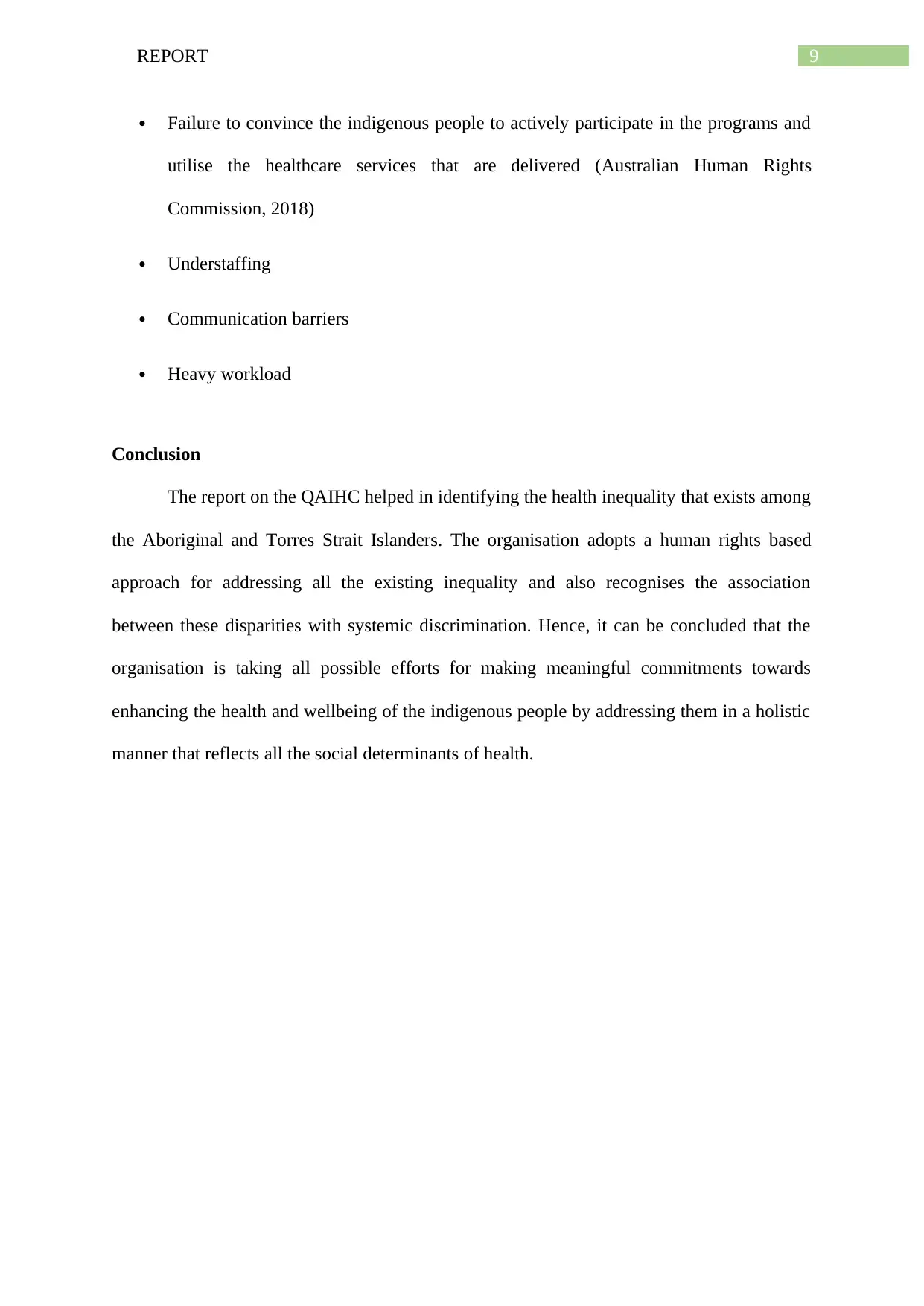
9REPORT
Failure to convince the indigenous people to actively participate in the programs and
utilise the healthcare services that are delivered (Australian Human Rights
Commission, 2018)
Understaffing
Communication barriers
Heavy workload
Conclusion
The report on the QAIHC helped in identifying the health inequality that exists among
the Aboriginal and Torres Strait Islanders. The organisation adopts a human rights based
approach for addressing all the existing inequality and also recognises the association
between these disparities with systemic discrimination. Hence, it can be concluded that the
organisation is taking all possible efforts for making meaningful commitments towards
enhancing the health and wellbeing of the indigenous people by addressing them in a holistic
manner that reflects all the social determinants of health.
Failure to convince the indigenous people to actively participate in the programs and
utilise the healthcare services that are delivered (Australian Human Rights
Commission, 2018)
Understaffing
Communication barriers
Heavy workload
Conclusion
The report on the QAIHC helped in identifying the health inequality that exists among
the Aboriginal and Torres Strait Islanders. The organisation adopts a human rights based
approach for addressing all the existing inequality and also recognises the association
between these disparities with systemic discrimination. Hence, it can be concluded that the
organisation is taking all possible efforts for making meaningful commitments towards
enhancing the health and wellbeing of the indigenous people by addressing them in a holistic
manner that reflects all the social determinants of health.
Secure Best Marks with AI Grader
Need help grading? Try our AI Grader for instant feedback on your assignments.
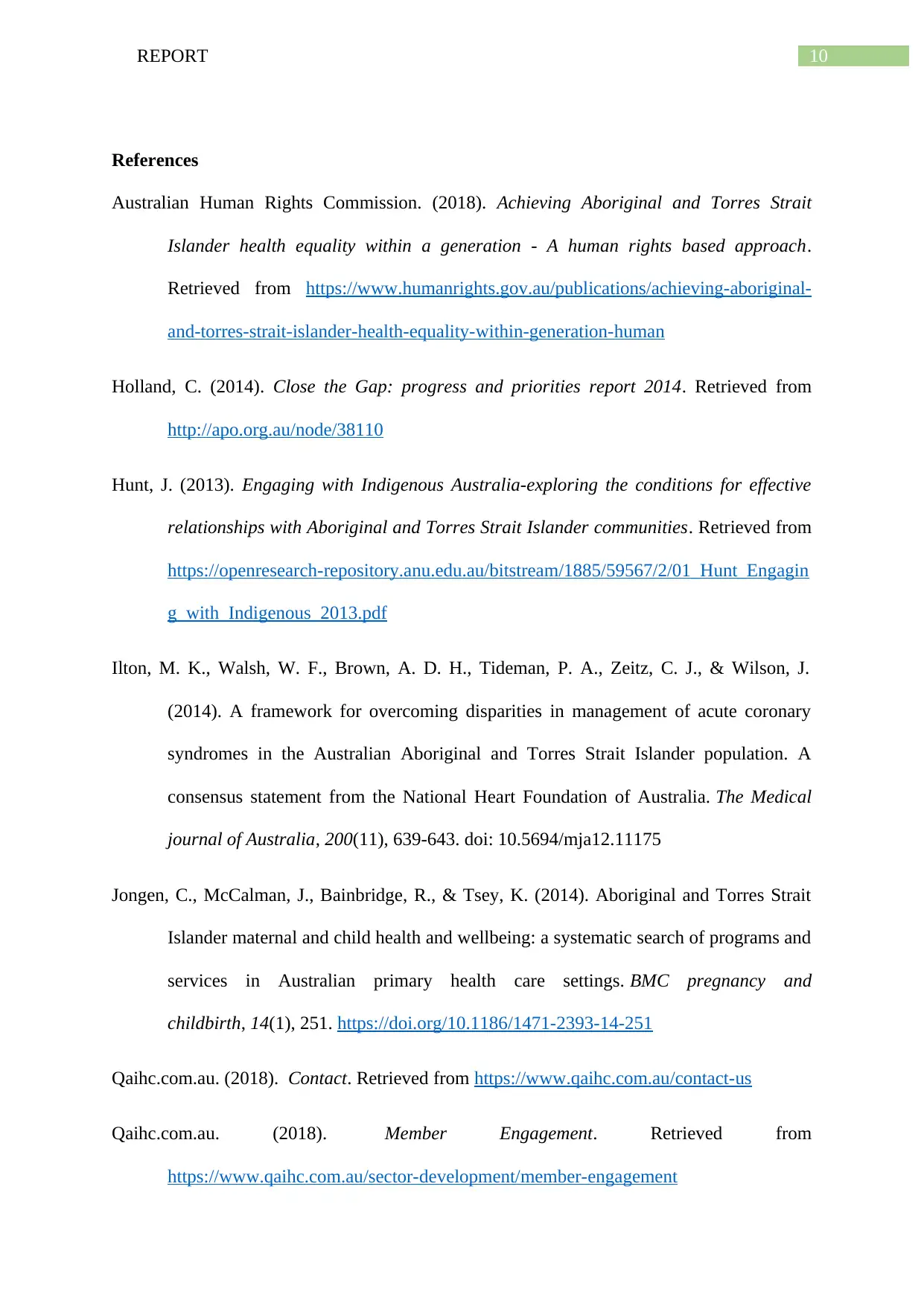
10REPORT
References
Australian Human Rights Commission. (2018). Achieving Aboriginal and Torres Strait
Islander health equality within a generation - A human rights based approach.
Retrieved from https://www.humanrights.gov.au/publications/achieving-aboriginal-
and-torres-strait-islander-health-equality-within-generation-human
Holland, C. (2014). Close the Gap: progress and priorities report 2014. Retrieved from
http://apo.org.au/node/38110
Hunt, J. (2013). Engaging with Indigenous Australia-exploring the conditions for effective
relationships with Aboriginal and Torres Strait Islander communities. Retrieved from
https://openresearch-repository.anu.edu.au/bitstream/1885/59567/2/01_Hunt_Engagin
g_with_Indigenous_2013.pdf
Ilton, M. K., Walsh, W. F., Brown, A. D. H., Tideman, P. A., Zeitz, C. J., & Wilson, J.
(2014). A framework for overcoming disparities in management of acute coronary
syndromes in the Australian Aboriginal and Torres Strait Islander population. A
consensus statement from the National Heart Foundation of Australia. The Medical
journal of Australia, 200(11), 639-643. doi: 10.5694/mja12.11175
Jongen, C., McCalman, J., Bainbridge, R., & Tsey, K. (2014). Aboriginal and Torres Strait
Islander maternal and child health and wellbeing: a systematic search of programs and
services in Australian primary health care settings. BMC pregnancy and
childbirth, 14(1), 251. https://doi.org/10.1186/1471-2393-14-251
Qaihc.com.au. (2018). Contact. Retrieved from https://www.qaihc.com.au/contact-us
Qaihc.com.au. (2018). Member Engagement. Retrieved from
https://www.qaihc.com.au/sector-development/member-engagement
References
Australian Human Rights Commission. (2018). Achieving Aboriginal and Torres Strait
Islander health equality within a generation - A human rights based approach.
Retrieved from https://www.humanrights.gov.au/publications/achieving-aboriginal-
and-torres-strait-islander-health-equality-within-generation-human
Holland, C. (2014). Close the Gap: progress and priorities report 2014. Retrieved from
http://apo.org.au/node/38110
Hunt, J. (2013). Engaging with Indigenous Australia-exploring the conditions for effective
relationships with Aboriginal and Torres Strait Islander communities. Retrieved from
https://openresearch-repository.anu.edu.au/bitstream/1885/59567/2/01_Hunt_Engagin
g_with_Indigenous_2013.pdf
Ilton, M. K., Walsh, W. F., Brown, A. D. H., Tideman, P. A., Zeitz, C. J., & Wilson, J.
(2014). A framework for overcoming disparities in management of acute coronary
syndromes in the Australian Aboriginal and Torres Strait Islander population. A
consensus statement from the National Heart Foundation of Australia. The Medical
journal of Australia, 200(11), 639-643. doi: 10.5694/mja12.11175
Jongen, C., McCalman, J., Bainbridge, R., & Tsey, K. (2014). Aboriginal and Torres Strait
Islander maternal and child health and wellbeing: a systematic search of programs and
services in Australian primary health care settings. BMC pregnancy and
childbirth, 14(1), 251. https://doi.org/10.1186/1471-2393-14-251
Qaihc.com.au. (2018). Contact. Retrieved from https://www.qaihc.com.au/contact-us
Qaihc.com.au. (2018). Member Engagement. Retrieved from
https://www.qaihc.com.au/sector-development/member-engagement
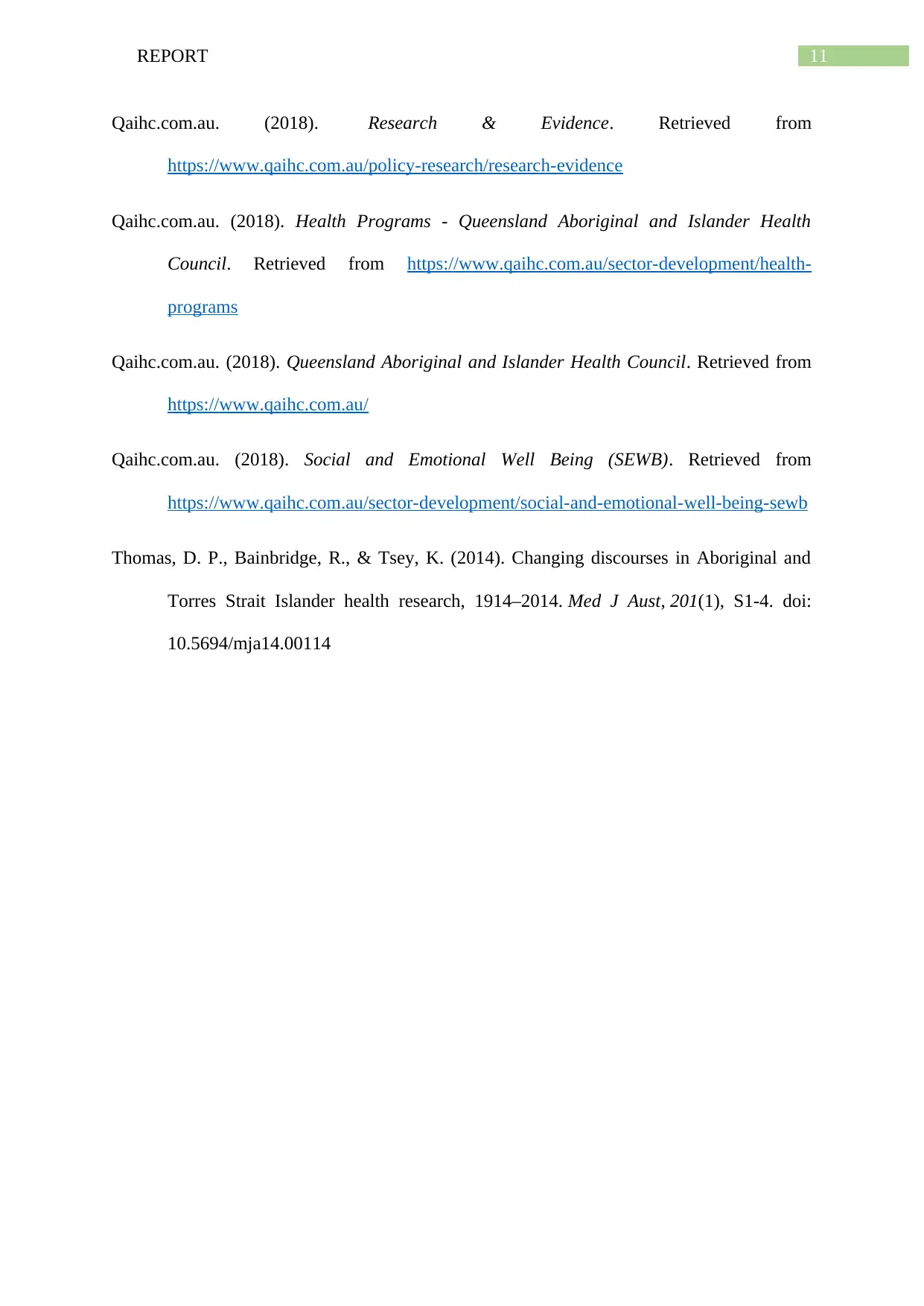
11REPORT
Qaihc.com.au. (2018). Research & Evidence. Retrieved from
https://www.qaihc.com.au/policy-research/research-evidence
Qaihc.com.au. (2018). Health Programs - Queensland Aboriginal and Islander Health
Council. Retrieved from https://www.qaihc.com.au/sector-development/health-
programs
Qaihc.com.au. (2018). Queensland Aboriginal and Islander Health Council. Retrieved from
https://www.qaihc.com.au/
Qaihc.com.au. (2018). Social and Emotional Well Being (SEWB). Retrieved from
https://www.qaihc.com.au/sector-development/social-and-emotional-well-being-sewb
Thomas, D. P., Bainbridge, R., & Tsey, K. (2014). Changing discourses in Aboriginal and
Torres Strait Islander health research, 1914–2014. Med J Aust, 201(1), S1-4. doi:
10.5694/mja14.00114
Qaihc.com.au. (2018). Research & Evidence. Retrieved from
https://www.qaihc.com.au/policy-research/research-evidence
Qaihc.com.au. (2018). Health Programs - Queensland Aboriginal and Islander Health
Council. Retrieved from https://www.qaihc.com.au/sector-development/health-
programs
Qaihc.com.au. (2018). Queensland Aboriginal and Islander Health Council. Retrieved from
https://www.qaihc.com.au/
Qaihc.com.au. (2018). Social and Emotional Well Being (SEWB). Retrieved from
https://www.qaihc.com.au/sector-development/social-and-emotional-well-being-sewb
Thomas, D. P., Bainbridge, R., & Tsey, K. (2014). Changing discourses in Aboriginal and
Torres Strait Islander health research, 1914–2014. Med J Aust, 201(1), S1-4. doi:
10.5694/mja14.00114
1 out of 12
Related Documents
Your All-in-One AI-Powered Toolkit for Academic Success.
+13062052269
info@desklib.com
Available 24*7 on WhatsApp / Email
![[object Object]](/_next/static/media/star-bottom.7253800d.svg)
Unlock your academic potential
© 2024 | Zucol Services PVT LTD | All rights reserved.





